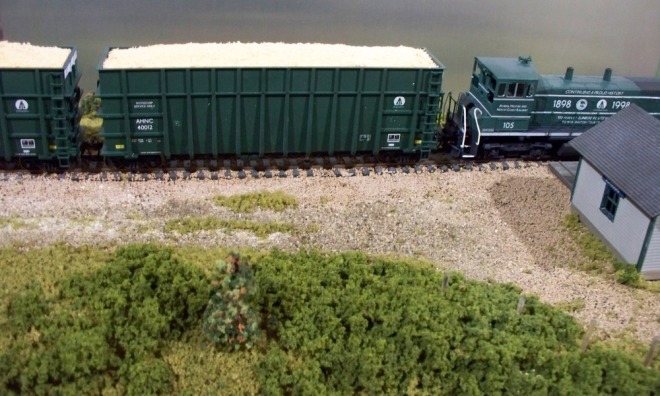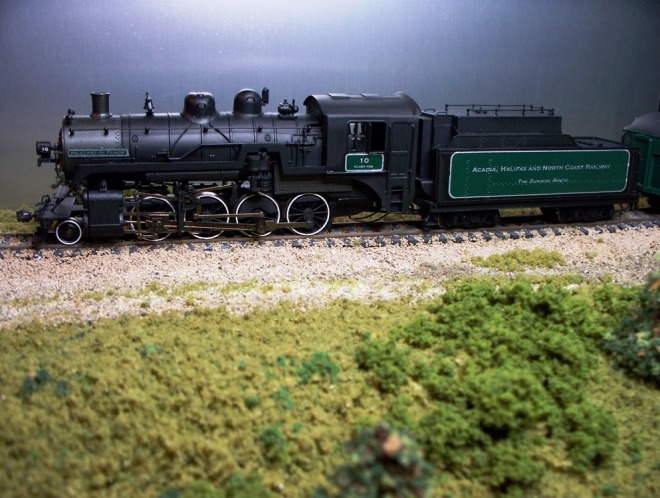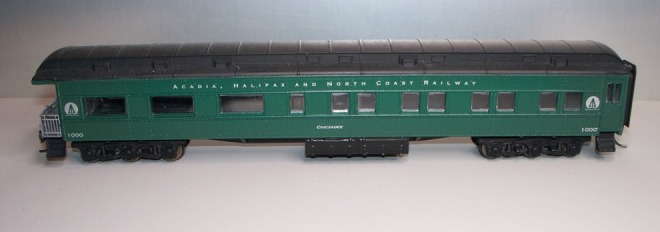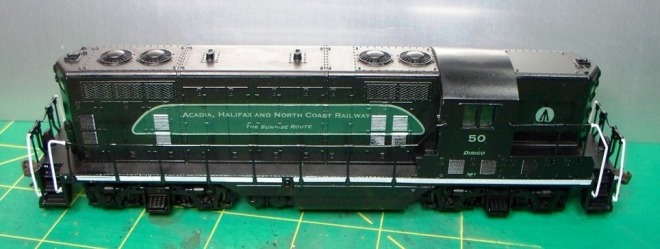In the waning days of 2015 I remembered I have once again left my readers in the dark for nearly a year. Things have been busy on both the 1:1 and 1:87 railroads which occupy much of my time!
The 1:1 railroad I work for suffered badly during the phenomenal Winter of 2015, with nearly a month of back-to-back snowstorms landing eight feet of snow on the region and taking a major toll on equipment availability. Things were not put to right until well into the spring, and a large part of our overall focus and effort for the remainder of the year has been to ensure we have taken steps to prepare ourselves for the next winter season so that we do not have a repeat of last year, no matter what Mother Nature brings. So far, as I write this on a nearly 60 degree day just a few days before Christmas, it’s hard to believe it could happen again. Then again, last December was pretty benign as well, and in fact it wasn’t until late January that the snows came repeatedly and in earnest. I had better not be complacent!
On the Acadia, Halifax and North Coast, much progress has been made. As mentioned in my last post, the fleet is indeed complete, or at least if and until I decide to expand it! The roster today stands at 23 locomotives, all DCC equipped and now in the process of receiving LED headlights, ditch lights, and red markers on both ends (this is why I spring for six function DCC decoders!).
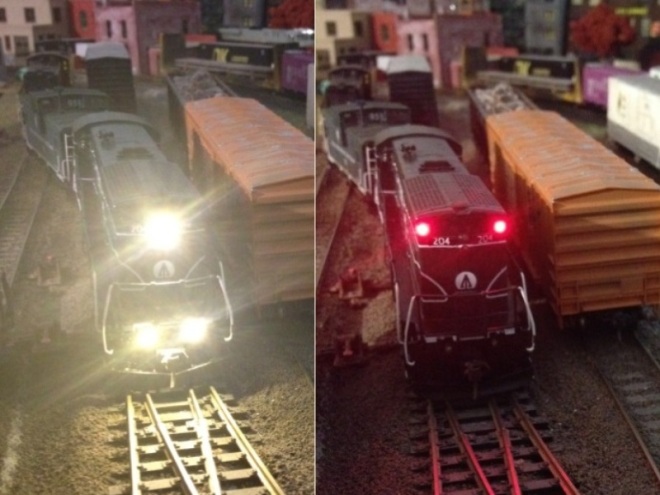
There are also 98 freight cars painted and lettered for AHNC, 11 passenger cars, two “Remote Control Lead Vans” (cabooses equipped to remotely control locomotives), and 14 pieces of maintenance of way and company service equipment (ballast hoppers, plows and spreaders, etc.). There are a few AHNC cars and locomotives floating around out there which I have given to friends over the years as well.
I have also built a few structures, including an entire engine service and car shop complex as seen below.

Even if the AHNC roster stays as is into the future (what are the odds of that?), I have already found ways to expand the fleet. I now have an affiliate tourist operation called the Black Woods and Schoodic Mountain Scenic Railroad which will operate over a portion of the AHNC. Trivia bit – I had considered the name Black Woods and Schoodic Mountain early on while developing the concept of what has become the AHNC, so the scenic railroad is a bit of a nod to “what might have been”. I also decided to establish an equipment leasing subsidiary called Acadia Rail Leasing. Both of these subsidiary operations will be a good excuse to retain and operate pieces of my model railroad collection which otherwise aren’t a good “fit” for the AHNC’s roster, like BWSX’s neat little Baldwin S-12 (below) and one of those brawny but cool-looking GE C32-8s which is being rehabbed to join the ARLX lease fleet (the maroon locomotive in the photo of the shop complex above).
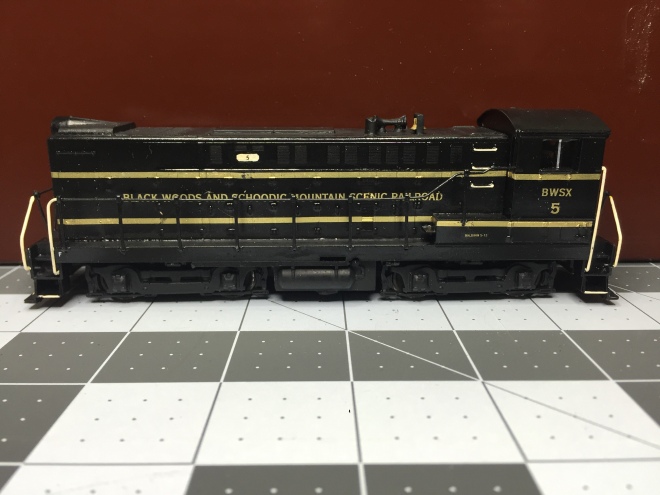
Unfortunately, my ability to create custom decals for these projects has been greatly hampered by the age and increasingly erratic operation of the ALPS printer I have owned for many years. It still occasionally feels up to the task, but more often I get error messages and it simply refuses to work. Someday soon I will have to seek another way, but for now I keep trying and use it when it cooperates.
Some, albeit small, progress has been made on the construction of the model railroad itself this year. Beginning in late summer I dismantled a rather massive bookcase in the basement, made several trips to home improvement stores to purchase lumber and other necessary construction supplies for the layout, moved years of stored items around as well as I could to make room to repaint the basement walls, and purchased several hundred dollars’ worth of Code 83 flex track and turnouts.
Even these preliminary tasks have shown me something – up until now, I had accomplished what I do in this hobby as pretty much a solitary activity. Yes, I belong to the Coastal Mountain modular group and I am not a loner hobbyist by any means, but the concept of the AHNC, and all of more than 150 or so pieces of equipment and structures, were all done by me alone. Then, when I began to take even the first tentative steps to build a layout, I realized this is a task few accomplish by themselves, and I have certainly welcomed the help I have received thus far! My dear wife, who has been very supportive of my hobby all along, assisted me with the task of painting the basement walls. My friend Jeff Turner of GC&M fame also came over to help choose and lug lumber and showed me the basics of benchwork construction. For the first time in several years the table saw in my basement was used for its intended purpose, rather than being… a table (uh, never mind that photo above of my new shop facility sitting atop it) .
I hired another good friend of mine, Mike Tylick, a retired art teacher and well-known model railroader and professional layout designer who has appeared many times in the model railroad press, to take a look at the hand drawn track plan pictured in my last post. Mike took that along with my list of “givens and druthers” and offered many critiques, tweaks, and suggestions I would never have though of, and HUGELY improved the plan. I discovered, not really a surprise to anyone who knows me, that I was being a bit too linear in my thinking. Mike busted that up just enough to make things really work, but still kept within my rather steep wish list which included no visible tunnels and no “spaghetti bowl” of tracks. I’m glad to say the resultant track plan is not completely unrecognizable from what I had started with, so I guess I did some things right, but wow is it much better, and Mike readily saw what the things I didn’t really like (he didn’t either!) and found a solution. I think it’ll be a great balance of operation and scenery, which is exactly what I wanted.
Finally going into high gear with layout construction does still need to wait for some further preparatory work – I need to hire contractors to relocate some plumbing and install new overhead lighting and additional electrical outlets throughout the basement. For the sake of my sanity and my homeowner’s policy, those are things I prefer to leave to professionals! In the meantime I am proceeding with building scenes like the shop facility, which can be installed in a modular fashion when the benchwork does get built.
I am looking forward to 2016, which will see even more progress, even dare I say a completed main line to finally operate trains on? We shall see, but with the help of my friends, I’m sure I can do it. In the meantime I’ll make a resolution for the upcoming year, to post to my blog more frequently, and feature reports of continued layout progress and things which my readers have asked about such as an illustrated roster.
In the meantime, thanks and best wishes to my friends and readers in this holiday season! More to come… soon!






